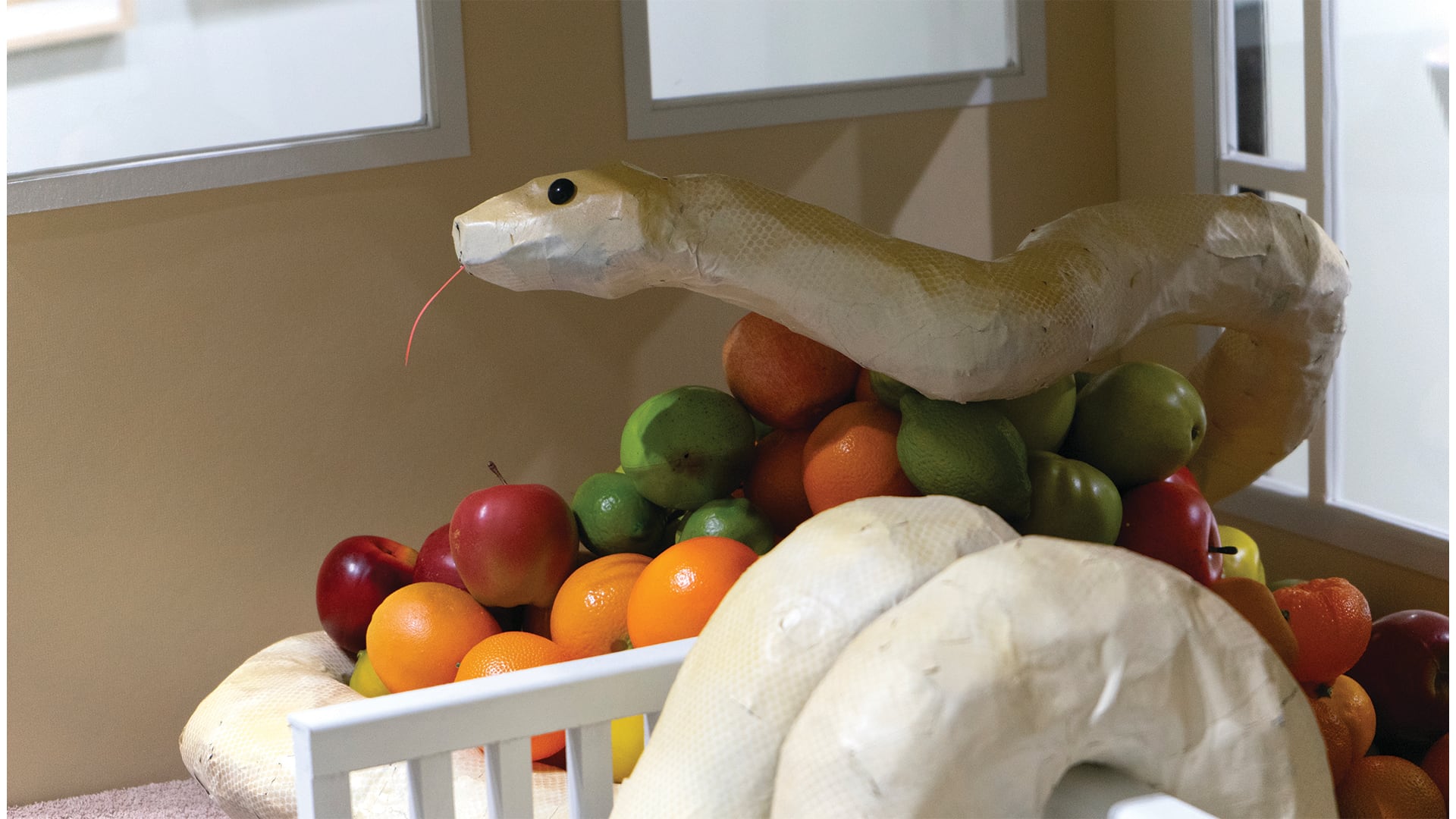Dolphins enjoy a positive public image despite their sexually aggressive tendencies and other well-documented, generally skuzzy behavior. It’s not that snakes haven’t done anything to deserve their reputation for striking immediate fear into the hearts of humans and nonhumans alike, but maybe someone who handles dolphins’ press relations can rehab snakes’ public images?
Visual artist Maria Lux appears to have answered this call with her exhibition Heart and Mind, Blood and Nerves at the Kenton neighborhood artist collective Carnation Contemporary, which opened on Saturday, July 5. On display through July 27, HMBN is a fairly straightforward show that, through installations and black-and-red collages, could either change viewers’ perception of serpents, or stand as a rare space outside a zoo or pet shop honoring our cold-blooded besties.
Lux’s art practice turns to animals for the answers to humanity’s greatest questions. HBMN pays tribute to the snakes and researchers who create lifesaving medicine from snake venom. Several fat pill bottles rest on gallery shelves with labels describing antivenoms and other snake-derived medicines, explaining which species patients owe their lives to and what effects their medicines alleviate. Color-coded bottle caps distinguish which substances are finalized, while those still in clinical trials reveal the conditions that venoms are helping treat, like stroke, Altzheimer’s and cancer. Labels on both types of bottles offer a fascinating trove of pharmaceutical and zoological trivia.
Near the wall-mounted shelves are framed collages with both grayscale and red-tone images spliced together, anchored with appropriated text and approximate titles (Carnation Contemporary did not offer a gallery map during Lux’s opening reception, and a gallery attendant was not readily identified to answer patron questions).
Though not a constant throughout the collages, the black-and-white pictures seemed sourced from art antiquity or outdated yet illustratively rich scientific textbooks. Mind and Nerves, for example, lays human brain diagrams on top of what appears to be a brood of vipers and an artist’s illustration of the Greek mythological figure Medusa. Her snakelike hair overlaps with the vipers, the brain’s wrinkles and other anatomical structures to form a nest of flowing, richly segmented lines. It’s hard to tell where one organism ends and another begins, perhaps a meditation on how deeply snakes are ingrained in the human psyche.
Snakes aren’t the only animals Lux pays tribute to in HMBN. The Making of Anti-Venom remembers the horses used to synthesize antivenom. Their size was believed to both protect them from the administered levels of venom while creating a useful-sized supply of the snake antidote. Rodents are also honored in In Vitro Tests, with silhouettes of mice and a wire removed to draw attention to how their bodies were used to study poison (to say nothing of how many have died feeding lab snakes).
Lux also finds parallels between mystic traditions and snake biology. Mother Mary imposes a red snake outline at the feet of a typical depiction of Mary, Jesus’ mother. Just as Mary birthed Christ as a virgin, snakes have been observed born from immaculate conception in unfertilized eggs. Existential Snakes posits that the caduceus—that wand with two snakes that you see at hospitals or on the military’s medical units—was how the ancients conceptualized what we also now know to be the structure of DNA strands. David and Goliath frames a red close-up of a homoerotic male torso with text opining how snakes developed venom, connecting it with one of the Bible’s most well-known stories.
“A snake is vulnerable, limbless and malleable with no tusks or claws to restrain prey,” the piece’s text reads. “Venom seduces the bitten animal and then swiftly corrupts its flesh. Venom evolved as a clinical advantage over brute force.”
The exhibition’s piece de resistance is a scale-model installation of a giant snake spilling out of a suburban house, coiled around a hoard of apples and oranges. It’s a playful piece of work—dreamlike or nightmarish, depending on how snakes strike you. A single red apple also sits on a shelf, an obvious allusion to the Garden of Eden and the Fall of Man described in Genesis.
HMBN probably won’t single-handedly cure ophidiophobia, but Lux’s work playfully yet effectively demonstrates why people shouldn’t stay bound to their fears, while also honoring the people and animals whose work has saved an untold number of lives. Slither in this summer to at least learn something new for trivia night.
SEE IT: Heart and Minds, Blood and Nerves by Maria Lux at Carnation Contemporary, 8371 N Interstate Ave., #3, carnationcontemporary.com. Noon–5 pm Saturday and Sunday. Free.

